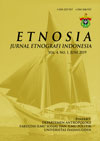Abstract
This is a review of Mernissi’s Beyond the Veil, one of the most influential book discussing Islam and gender.I have to admit that I have not read Mernissi before I take a course called Anthropology and World Religions focusing in Islam in the University of Auckland. Later I know that the reason why her name rarely echoed in anthropological atmosphere in Indonesia (particularly in Sulawesi) is because Mernissi only well-known in gender studies (especially in Islam) and Islamic studies. I know it because the only colleague who knows Mernissi is my professor who studied anthropology and gender (and Islam). Beyond the Veil is an interesting book. It explores the relation and the dynamics within male-female Muslims which even I, as a Muslim, have not realised it before. Excluding the introduction (with three different versions) and the conclusion, Beyond the Veil is divided into two parts. Part one consist of three chapters which are more theoretic (or conceptual) background of the book and I think, it would be easier for the readers to understand the context and to grasp Mernissi’s arguments briefly. Part two consist of six chapters which are more ethnographic oriented (fieldwork-based) since it tells the readers about the dynamics between men and women in modern Morocco (as a case or sample of modern Islamic society).
References
Abu-Lughod, L. (2002). ‘Do Muslim Women Really Need Saving? Anthropological Reflections on Cultural Relativism and Its Others’. In American Anthropologist, vol. 104, no. 3, pp. 783-790.
Chapman, M. (2016). ‘Feminist Dilemmas and the Agency of Veiled Muslim Women: Analysing Identities and Social Representations’. In European Journal of Women’s Studies, vol. 23, no. 3, pp. 237-250.
Deeb, L. (2009). ‘Piety Politics and the Role of a Transnational Feminist Analysis’. In Journal of the Royal Anthropological Institute (N.S), pp. 112-126.
Khalifa, N. et.al. (2011). ‘Beliefs about Jinn, Black Magic and the Evil Eye among Muslims: Age, Gender and First Language Influences’. In International Journal of Culture and Mental Health, vol. 4, no. 1, pp. 68-77.
Marx, K., Engels, F. (1976). The German Ideology Vol. 1. Moscow: Progress Publisher.
Mernissi, F. (2011). Beyond the Veil: Male-Female Dynamics in Muslim Society. London: Saqi Books.
Kulenovic, T. (2006). ‘A Veil (hijab) as a Public Symbol of a Muslim Woman Modern Identity. In Coll. Antropol, vol. 30, no. 4, pp. 713–718.
Varisco, D.M. (2005). Islam Obscured: The Rhetoric of Anthropological Representation. New York: Palgrave Macmillan.
Wagner, W. et al. (2012). ‘The Veil and Muslim Women's Identity: Cultural Pressures and Resistance to Stereotyping’. In Culture and Psychology, vol. 18, no. 4, pp. 521–541.





